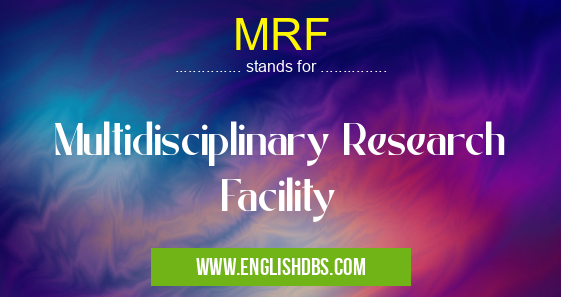What does MRF mean in RESEARCH
MRF stands for Multidisciplinary Research Facility. It is a shared research facility that typically provides scientists and researchers from various disciplines access to specialized equipment, technologies, and expertise. MRFs are designed to foster collaboration and innovation across disciplines, enabling research advancements that might not be possible otherwise.

MRF meaning in Research in Academic & Science
MRF mostly used in an acronym Research in Category Academic & Science that means Multidisciplinary Research Facility
Shorthand: MRF,
Full Form: Multidisciplinary Research Facility
For more information of "Multidisciplinary Research Facility", see the section below.
Key Functions of MRFs
- Provide researchers with access to state-of-the-art equipment and technologies that may not be available in their own laboratories.
- Foster collaboration and interdisciplinary research by bringing together scientists from diverse fields.
- Facilitate knowledge sharing and training opportunities through workshops, seminars, and other events.
- Support the development of innovative research methodologies and techniques.
- Promote the development of research infrastructure and capabilities in a particular region or institution.
Types of MRFs
MRFs can vary widely in terms of their size, scope, and areas of specialization. Some common types of MRFs include:
- Core Facilities: These MRFs provide essential equipment and services that are commonly used by researchers in multiple disciplines, such as microscopy, flow cytometry, and DNA sequencing.
- Specialized Facilities: These MRFs focus on specific research areas, such as nanoscience, materials science, or computational biology. They provide specialized expertise and equipment tailored to those fields.
- Collaborative Facilities: These MRFs are established through partnerships between multiple institutions or organizations to combine resources and expertise for large-scale research projects.
Benefits of MRFs
MRFs offer numerous benefits to researchers, institutions, and the scientific community as a whole:
- Enhanced Research Capabilities: MRFs provide researchers with access to advanced technologies and expertise, enabling them to pursue research projects that would not be possible within their own institutions.
- Increased Collaboration: MRFs facilitate collaboration between researchers from different disciplines, leading to innovative and interdisciplinary research outcomes.
- Resource Optimization: MRFs allow institutions to share expensive equipment and resources, optimizing their use and reducing costs.
- Training Opportunities: MRFs provide training and professional development opportunities for researchers, enhancing their skills and knowledge.
- Economic Impact: MRFs can attract researchers and businesses to a region, stimulating economic growth and development.
Essential Questions and Answers on Multidisciplinary Research Facility in "SCIENCE»RESEARCH"
What is the Multidisciplinary Research Facility (MRF)?
The Multidisciplinary Research Facility (MRF) is a state-of-the-art facility that provides researchers with access to advanced scientific equipment and resources. It fosters collaboration among researchers from diverse disciplines, enabling groundbreaking discoveries and advancements.
What types of research projects are supported by the MRF?
The MRF supports research projects that span a wide range of disciplines, including biology, chemistry, physics, engineering, and medicine. It provides a platform for researchers to address complex scientific questions and develop innovative solutions to global challenges.
What equipment and services are available at the MRF?
The MRF is equipped with cutting-edge instrumentation, including electron microscopes, mass spectrometers, DNA sequencers, and high-performance computing systems. It also offers specialized services such as sample preparation, data analysis, and research consultation.
Who can use the MRF?
The MRF is open to researchers from universities, research institutions, and industry. Researchers can access the facility through collaborations with MRF staff or by submitting a proposal for project approval.
How do I apply for access to the MRF?
Researchers interested in using the MRF can submit a proposal outlining their research project and equipment needs. Proposals are reviewed by a committee of experts who evaluate the scientific merit and feasibility of the project.
What are the costs associated with using the MRF?
The costs of using the MRF vary depending on the equipment and services required. Researchers may incur fees for equipment usage, sample preparation, and data analysis.
How can I stay informed about MRF events and opportunities?
Researchers can subscribe to the MRF newsletter, follow social media accounts, or visit the MRF website to stay updated on upcoming events, workshops, and funding opportunities.
Final Words: MRFs play a crucial role in supporting scientific research by providing researchers with access to sophisticated equipment, expertise, and collaborative opportunities. They foster interdisciplinary research, promote innovation, and contribute to the advancement of science and technology. As scientific research becomes increasingly complex and interdisciplinary, MRFs are expected to continue to grow in importance and become essential components of research infrastructure.
MRF also stands for: |
|
| All stands for MRF |
